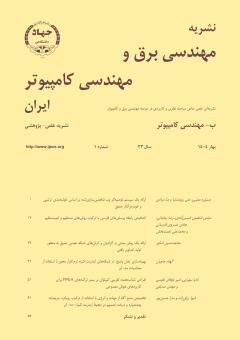بهینهسازی زمان پاسخ در شبکههای اینترنت اشیای نرمافزارمحور با استفاده از محاسبات مه- ابر
محورهای موضوعی : electrical and computer engineering
1 - گروه مهندسی کامپیوتر، دانشگاه بجنورد، بجنورد، ايران،
کلید واژه: اینترنت اشیا, خانه هوشمند, شبکههای نرمافزارمحور, محاسبات ابر, محاسبات مه, نظریه صف.,
چکیده مقاله :
اینترنت اشیا از ابر برای پردازش اطلاعات رسیده از وسایل الکترونیکی استفاده میکند. سرورهای قدرتمند و دور از حسگرها، پردازش را انجام میدهند. وسایل اینترنت اشیا درخواستها را به ابر ارسال کرده و نتایج را از آن دریافت میکنند. در بعضی از کاربردهای اینترنت اشیا، زمان پاسخ و تأخیر مهم میباشد؛ بنابراین باید هرچه بیشتر زمان تأخیر را کاهش داد. ارسال اطلاعات به ابر، خود مستلزم ایجاد تأخیر میباشد؛ لذا استفاده از مه در کنار ابر در اینترنت اشیا نقش اساسی را ایفا میکند.
استفاده از مه و رایانش ابری در زمینه اینترنت اشیا، موضوع قابل توجه برای پژوهشگران میباشد. برای تسهیل این فرایند، شبکههای نرمافزارمحور به عنوان یک جزء حیاتی ظاهر شدهاند. این شبکهها امکان کنترل و مدیریت متمرکز شبکه را فراهم میکنند. همچنین با هدایت پویای جریانهای داده به منابع مه یا ابر بر اساس شرایط زمان واقعی، استفاده بهینه از منابع و اتصال یکپارچه را تضمین میکنند. محاسبات مه به استقرار منابع در نزدیکی حسگر شبکه اشاره دارد. با انجام این کار، محاسبات مه با هدف کاهش تأخیر و استفاده از پهنای باند در حالی که عملکرد کلی سیستم را بهبود میبخشد، میپردازد. این کار را با استفاده از قابلیتهای محاسباتی محلی برای پردازش دادهها انجام میدهد.
این پژوهش با استفاده از معماری پیشنهادی برای شبکههای اینترنت اشیا و مدلسازی قسمتهای مختلف این معماری با استفاده از نظریه صف، زمان پاسخ را توسط محاسبات مه- ابر کاهش داده و پارامترهای کیفیت سرویس شبکه را توسط آنالیز ریاضی به دست میآورد. در ادامه نیز نمودارهای مقایسه انرژی باقیمانده و تأخیر برای کاربردهای سلامتی و روشنایی و همچنین نمودارهای مقایسهای استفاده و عدم استفاده از محاسبات مه- ابر رسم شده است. نمودارها نشان میدهند که استفاده از محاسبات مه- ابر، زمان پاسخ را کاهش میدهد و کاربرد روشنایی با استفاده از مه، انرژی باقیمانده بیشتر و کاربرد سلامتی، تأخیر کمتر دارد. شبیهسازی با استفاده از نرمافزار 2NS در کاربرد خانه هوشمند انجام شده است.
The Internet of Things uses the cloud to process information received from electronic devices. Powerful servers located far from the sensors perform the processing. IoT devices send requests to the cloud and receive results from it. In some IoT applications, response time and latency are important. Therefore, latency should be reduced as much as possible. Sending information to the cloud itself entails latency. Therefore, the use of fog along with the cloud plays a fundamental role in the IoT. The use of fog and cloud computing in the field of IoT is a significant topic for researchers. To facilitate this process, software-defined networks have emerged as a vital component. These networks enable centralized control and management of the network. They also ensure optimal resource utilization and seamless connectivity by dynamically directing data flows to fog or cloud resources based on real-time conditions. Fog computing refers to the deployment of resources near the network sensor. By doing so, fog computing aims to reduce latency and bandwidth usage while improving overall system performance. It does this by utilizing local computing capabilities to process data. This research uses the proposed architecture for IoT networks and modeling different parts of this architecture using queuing theory to reduce response time using fog-cloud computing and obtain network quality of service parameters through mathematical analysis. In the following, the residual energy and latency comparison graphs for health and lighting applications as well as the use and non-use of fog-cloud computing are plotted. The graphs show that the use of fog-cloud computing reduces response time and the lighting application using fog has more residual energy and the health application has less latency. The simulation was performed using NS2 software in the smart home application.
